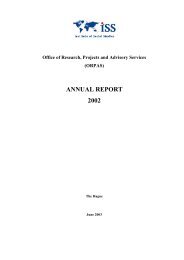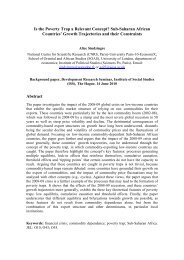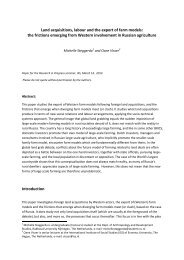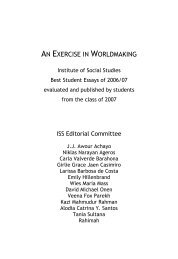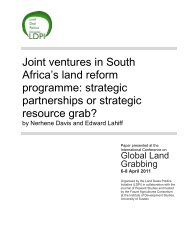AN EXERCISE IN WORLDMAKING 2009 - ISS
AN EXERCISE IN WORLDMAKING 2009 - ISS
AN EXERCISE IN WORLDMAKING 2009 - ISS
Create successful ePaper yourself
Turn your PDF publications into a flip-book with our unique Google optimized e-Paper software.
9<br />
One Size Doesn’t Fit All:<br />
Tailoring Credit Programs<br />
along the Logic of the Poor<br />
BERNICE CAMPOS ROLD<strong>AN</strong><br />
<strong>IN</strong>TRODUCTION: M<strong>IN</strong>IMALIST OR COMPREHENSIVE?<br />
Microfinance has proved to be a potent concept in development. The<br />
1990s saw the upsurge of slogans such as ‘helping the poor help themselves’<br />
and ‘giving a hand up, not a handout’. The concept continues to<br />
benefit from immense support ‘across the political spectrum, in an era of<br />
domestic welfare reform and cutbacks on foreign aid budgets’ (Woolcock,<br />
1999: 17-18). Rogaly (1996, in Mosley and Hulme, 1998: 783) observes<br />
how the concept of providing loans to microenterprises for poverty<br />
alleviation has in recent years ‘generated enthusiasm bordering on<br />
hysteria’. It is a political concept that has captured the imagination of the<br />
left ‘by being redistributive and a direct approach to alleviating poverty,<br />
and to the right as facilitating the emergence of an independent, selfsustaining<br />
“penny capitalism”’.<br />
Discourse used to underscore the need for education and training to<br />
help the poor make the most out of credit. Development practitioners<br />
and credit providers thought along similar lines in that providing training<br />
in livelihood and financial literacy would unleash the poor’s entrepreneurial<br />
spirit, which would then enable the poor to work towards a better<br />
quality of life. Hickson (2001: 55) explains the logic behind this approach:<br />
‘[Some microfinance institutions] include technical training in<br />
their programs with the rationale that extremely poor people do not have<br />
the entrepreneurial skills or assets to use business loans productively’.<br />
Parallel to this approach, Hickson adds that other MFIs ‘take the view<br />
that minimalist programs are more likely to become sustainable and can<br />
95




